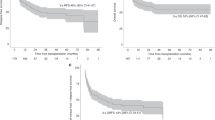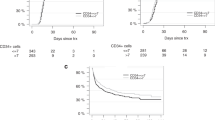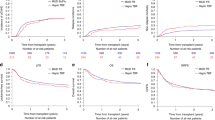Abstract
Little is known regarding the chimerism status after reduced-intensity conditioning transplantation when bone marrow is used as a stem cell source. We prospectively analyzed lineage-specific chimerism and retrospectively evaluated clinical outcomes in 80 adult patients who underwent unrelated donor bone marrow transplantation (URBMT) with fludarabine plus melphalan (FM) as the conditioning regimen. Mixed donor chimerism (MDC) was seen in 43 and 10 % of patients at days 14 and 28, respectively. Melphalan at ≤130 mg/m2 was associated with an increased incidence of MDC at day 28 (P = 0.03). Patients with MDC at day 14 showed a marginally increased risk of primary graft failure and a marginally decreased risk of graft-versus-host disease. In multivariate analysis, MDC at day 14 was associated with higher overall mortality (hazard ratio (HR) = 2.1; 95 % confidence interval (CI), 1.1–4.2; P = 0.04) and relapse rate (HR = 3.0; 95 % CI, 1.2–7.5; P = 0.02), but not with non-relapse mortality (HR = 1.8; 95 % CI, 0.70–4.6; P = 0.23). Thus, the FM regimen yields prompt complete donor chimerism after URBMT, but the melphalan dose significantly impacts the kinetics of chimerism. Chimerism status evaluation at day 14 may be instrumental in predicting relapse after URBMT with the FM regimen.



Similar content being viewed by others
References
Mattsson J, Ringden O, Storb R (2008) Graft failure after allogeneic hematopoietic cell transplantation. Biol Blood Marrow Transplant : J Am Soc Blood Marrow Transplant 14(1):165–170. doi:10.1016/j.bbmt.2007.10.025
Olsson R, Remberger M, Schaffer M, Berggren DM, Svahn BM, Mattsson J, Ringden O (2013) Graft failure in the modern era of allogeneic hematopoietic SCT. Bone Marrow Transplant 48(4):537–543. doi:10.1038/bmt.2012.239
Gahrton G, Iacobelli S, Bandini G, Bjorkstrand B, Corradini P, Crawley C, Hegenbart U, Morgan G, Kroger N, Schattenberg A, Schonland SO, Verdonck LF, Volin L, de Witte T, Niederwieser D, Myeloma Subcommittee of the E (2007) Peripheral blood or bone marrow cells in reduced-intensity or myeloablative conditioning allogeneic HLA identical sibling donor transplantation for multiple myeloma. Haematologica 92(11):1513–1518. doi:10.3324/haematol.11353
Holtick U, Albrecht M, Chemnitz JM, Theurich S, Skoetz N, Scheid C, von Bergwelt-Baildon M (2014) Bone marrow versus peripheral blood allogeneic haematopoietic stem cell transplantation for haematological malignancies in adults. Cochrane Database Syst Rev 4:CD010189. doi:10.1002/14651858.CD010189.pub2
Nagler A, Labopin M, Shimoni A, Niederwieser D, Mufti GJ, Zander AR, Arnold R, Greinix H, Cornelissen JJ, Jackson GH, Craddock C, Bunjes DW, Ganser A, Russell NH, Kyrcz-Krzemien S, Rocha V, Mohty M (2012) Mobilized peripheral blood stem cells compared with bone marrow as the stem cell source for unrelated donor allogeneic transplantation with reduced-intensity conditioning in patients with acute myeloid leukemia in complete remission: an analysis from the Acute Leukemia Working Party of the European Group for Blood and Marrow Transplantation. Biol Blood Marrow Transplant : J Am Soc Blood Marrow Transplant 18(9):1422–1429
Breuer S, Preuner S, Fritsch G, Daxberger H, Koenig M, Poetschger U, Lawitschka A, Peters C, Mann G, Lion T, Matthes-Martin S (2012) Early recipient chimerism testing in the T- and NK-cell lineages for risk assessment of graft rejection in pediatric patients undergoing allogeneic stem cell transplantation. Leukemia 26(3):509–519. doi:10.1038/leu.2011.244
Saito B, Fukuda T, Yokoyama H, Kurosawa S, Takahashi T, Fuji S, Takahashi N, Tajima K, Kim SW, Mori S, Tanosaki R, Takaue Y, Heike Y (2008) Impact of T cell chimerism on clinical outcome in 117 patients who underwent allogeneic stem cell transplantation with a busulfan-containing reduced-intensity conditioning regimen. Biol Blood Marrow Transplant : J Am Soc Blood Marrow Transplant 14(10):1148–1155. doi:10.1016/j.bbmt.2008.07.013
Huisman C, de Weger RA, de Vries L, Tilanus MG, Verdonck LF (2007) Chimerism analysis within 6 months of allogeneic stem cell transplantation predicts relapse in acute myeloid leukemia. Bone Marrow Transplant 39(5):285–291. doi:10.1038/sj.bmt.1705582
Baron F, Baker JE, Storb R, Gooley TA, Sandmaier BM, Maris MB, Maloney DG, Heimfeld S, Oparin D, Zellmer E, Radich JP, Grumet FC, Blume KG, Chauncey TR, Little MT (2004) Kinetics of engraftment in patients with hematologic malignancies given allogeneic hematopoietic cell transplantation after nonmyeloablative conditioning. Blood 104(8):2254–2262. doi:10.1182/blood-2004-04-1506
Mohty M, Avinens O, Faucher C, Viens P, Blaise D, Eliaou JF (2007) Predictive factors and impact of full donor T-cell chimerism after reduced intensity conditioning allogeneic stem cell transplantation. Haematologica 92(7):1004–1006
Moscardo F, Sanz J, Senent L, Cantero S, de la Rubia J, Montesinos P, Planelles D, Lorenzo I, Cervera J, Palau J, Sanz MA, Sanz GF (2009) Impact of hematopoietic chimerism at day +14 on engraftment after unrelated donor umbilical cord blood transplantation for hematologic malignancies. Haematologica 94(6):827–832. doi:10.3324/haematol.2008.000935
Baron F, Sandmaier BM (2006) Chimerism and outcomes after allogeneic hematopoietic cell transplantation following nonmyeloablative conditioning. Leukemia 20(10):1690–1700. doi:10.1038/sj.leu.2404335
Sugita J, Tanaka J, Hashimoto A, Shiratori S, Yasumoto A, Wakasa K, Kikuchi M, Shigematsu A, Miura Y, Tsutsumi Y, Kondo T, Asaka M, Imamura M (2008) Influence of conditioning regimens and stem cell sources on donor-type chimerism early after stem cell transplantation. Ann Hematol 87(12):1003–1008. doi:10.1007/s00277-008-0542-4
Valcarcel D, Martino R, Caballero D, Mateos MV, Perez-Simon JA, Canals C, Fernandez F, Bargay J, Muniz-Diaz E, Gonzalez M, San Miguel JF, Sierra J (2003) Chimerism analysis following allogeneic peripheral blood stem cell transplantation with reduced-intensity conditioning. Bone Marrow Transplant 31(5):387–392. doi:10.1038/sj.bmt.1703846
Terakura S, Atsuta Y, Sawa M, Ohashi H, Kato T, Nishiwaki S, Imahashi N, Yasuda T, Murata M, Miyamura K, Suzuki R, Naoe T, Ito T, Morishita Y, Nagoya B, Marrow Transplantation G (2011) A prospective dose-finding trial using a modified continual reassessment method for optimization of fludarabine plus melphalan conditioning for marrow transplantation from unrelated donors in patients with hematopoietic malignancies. Ann Oncol: Off J Eur Soc Med Oncol/ESMO 22(8):1865–1871. doi:10.1093/annonc/mdq673
Oran B, Giralt S, Saliba R, Hosing C, Popat U, Khouri I, Couriel D, Qazilbash M, Anderlini P, Kebriaei P, Ghosh S, Carrasco-Yalan A, de Meis E, Anagnostopoulos A, Donato M, Champlin RE, de Lima M (2007) Allogeneic hematopoietic stem cell transplantation for the treatment of high-risk acute myelogenous leukemia and myelodysplastic syndrome using reduced-intensity conditioning with fludarabine and melphalan. Biology of Blood and Marrow Transplantation: Journal of the American Society for Blood and Marrow Transplantation 13(4):454–462. doi:10.1016/j.bbmt.2006.11.024
Imahashi N, Ohashi H, Arita K, Kitamura K, Takahashi T, Ozawa Y, Miyamura K (2010) Acute lymphoblastic leukemia of male-recipient origin demonstrating female karyotype after cord blood transplantation. J Clin Oncol: Off J Am Soc Clin Oncol 28(36):e750–e752. doi:10.1200/jco.2010.30.5813
Ohashi H, Kato C, Fukami S, Saito H, Hamaguchi M (2005) Leukemic relapse in the central nervous system after allogeneic stem cell transplantation with complete remission in the bone marrow and donor-type chimerism: report of two cases. Am J Hematol 79(2):142–146. doi:10.1002/ajh.20333
Morishima Y, Sasazuki T, Inoko H, Juji T, Akaza T, Yamamoto K, Ishikawa Y, Kato S, Sao H, Sakamaki H, Kawa K, Hamajima N, Asano S, Kodera Y (2002) The clinical significance of human leukocyte antigen (HLA) allele compatibility in patients receiving a marrow transplant from serologically HLA-A, HLA-B, and HLA-DR matched unrelated donors. Blood 99(11):4200–4206
Przepiorka D, Weisdorf D, Martin P, Klingemann HG, Beatty P, Hows J, Thomas ED (1995) 1994 Consensus Conference on Acute GVHD Grading. Bone Marrow Transplant 15(6):825–828
Sullivan KM, Agura E, Anasetti C, Appelbaum F, Badger C, Bearman S, Erickson K, Flowers M, Hansen J, Loughran T et al (1991) Chronic graft-versus-host disease and other late complications of bone marrow transplantation. Semin Hematol 28(3):250–259
Klein JP, Rizzo JD, Zhang MJ, Keiding N (2001) Statistical methods for the analysis and presentation of the results of bone marrow transplants. Part I: unadjusted analysis. Bone Marrow Transplant 28(10):909–915. doi:10.1038/sj.bmt.1703260
Scrucca L, Santucci A, Aversa F (2007) Competing risk analysis using R: an easy guide for clinicians. Bone Marrow Transplant 40(4):381–387. doi:10.1038/sj.bmt.1705727
Kanda Y (2013) Investigation of the freely available easy-to-use software 'EZR' for medical statistics. Bone Marrow Transplant 48(3):452–458. doi:10.1038/bmt.2012.244
Bryant A, Nivison-Smith I, Pillai ES, Kennedy G, Kalff A, Ritchie D, George B, Hertzberg M, Patil S, Spencer A, Fay K, Cannell P, Berkahn L, Doocey R, Spearing R, Moore J (2014) Fludarabine Melphalan reduced-intensity conditioning allotransplanation provides similar disease control in lymphoid and myeloid malignancies: analysis of 344 patients. Bone Marrow Transplant 49(1):17–23. doi:10.1038/bmt.2013.142
Petersen SL, Madsen HO, Ryder LP, Svejgaard A, Masmas TN, Dickmeiss E, Heilmann C, Vindelov LL (2004) Chimerism studies in HLA-identical nonmyeloablative hematopoietic stem cell transplantation point to the donor CD8(+) T-cell count on day + 14 as a predictor of acute graft-versus-host disease. Biol Blood Marrow Transplant : J Am Soc Blood Marrow Transplant 10(5):337–346. doi:10.1016/j.bbmt.2004.01.003
Bader P, Beck J, Frey A, Schlegel PG, Hebarth H, Handgretinger R, Einsele H, Niemeyer C, Benda N, Faul C, Kanz L, Niethammer D, Klingebiel T (1998) Serial and quantitative analysis of mixed hematopoietic chimerism by PCR in patients with acute leukemias allows the prediction of relapse after allogeneic BMT. Bone Marrow Transplant 21(5):487–495. doi:10.1038/sj.bmt.1701119
Barrios M, Jimenez-Velasco A, Roman-Gomez J, Madrigal ME, Castillejo JA, Torres A, Heiniger A (2003) Chimerism status is a useful predictor of relapse after allogeneic stem cell transplantation for acute leukemia. Haematologica 88(7):801–810
Rettinger E, Willasch AM, Kreyenberg H, Borkhardt A, Holter W, Kremens B, Strahm B, Woessmann W, Mauz-Koerholz C, Gruhn B, Burdach S, Albert MH, Schlegel PG, Klingebiel T, Bader P (2011) Preemptive immunotherapy in childhood acute myeloid leukemia for patients showing evidence of mixed chimerism after allogeneic stem cell transplantation. Blood 118(20):5681–5688. doi:10.1182/blood-2011-04-348805
Acknowledgments
This work was supported in part by a Grant (H25-Immunology-104) from the Ministry of Health, Labor and Welfare, Japan (M.M.).
Conflict of interest
H. Kiyoi received research funding from Bristol-Myers Squibb, Chugai Pharmaceutical Co. LTD., Kyowa Hakko Kirin Co. LTD., Dainippon Sumitomo Pharma, Zenyaku Kogyo, and FUJIFILM Corporation. The other authors have nothing to disclose.
Author information
Authors and Affiliations
Consortia
Corresponding author
Rights and permissions
About this article
Cite this article
Imahashi, N., Ohashi, H., Terakura, S. et al. Chimerism status after unrelated donor bone marrow transplantation with fludarabine-melphalan conditioning is affected by the melphalan dose and is predictive of relapse. Ann Hematol 94, 1139–1148 (2015). https://doi.org/10.1007/s00277-015-2312-4
Received:
Accepted:
Published:
Issue Date:
DOI: https://doi.org/10.1007/s00277-015-2312-4




